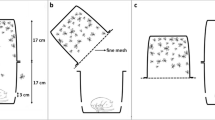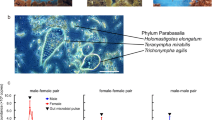Abstract
The most abundant dragonflies Brachythemis contaminata, Orthetrum sabina, Diplacodes trivialis, Pantala flavescens and Trithemis festiva in the tropical pond Idumban emerged from November to April during the years 1973,1974 and 1975. The date of initiation of emergence of all the species was synchronized and tied to the events following the north west monsoon in November. During the seasons '73–74 and '74–75, as many as 10,693 and 7,910 adults emerged; females outnumbered the males in all the 5 species; male populations of B. contaminata, O. sabina, D. trivialis, P. flavescens and T. festiva represented 47, 48, 46, 49 and 44% during the '73–74 season, 48, 48, 46, 46 and 49% during the '74–75 season, respectively. The adult dragonflies equivalent to 2,442 Kcal emerged from the Pond during the season '73–74. Of this, B. contaminata contributed 30%, D. trivialis 7%, O. sabina 12%, P. flavescens 23% and T. festiva 28%. For the season '74–75, the dragonflies equivalent to 1,602 Kcal emerged from the Pond and the contribution was in the following order: B. contaminata: 31%, O. sabina: 8%, D. trivialis: 13%, P. flavescens: 27% and T. festiva: 21%. Import of energy due to inoculation of B. contaminata eggs into the Pond Idumban was 73 Kcal/ year and the output from the Pond via emerging B. contaminata population alone amounted to 620 Kcal/ year; the net energy loss from the Pond was 548 Kcal/ year. During either season, as much as 99.7% of B. contaminata eggs failed to attain adulthood due to infertility (5.8%), unhatchability (12%) and predation during the egg and nymphal stages (82.5%). During the study, the GPP of the Pond was 26,073 Kcal/m2/ year, and output of energy through emergence of 5 dragonfly species amounted to 0.0045 Kcal/m2/year, i.e. 0.00002% of the GPP is lost through the emerging carnivorous odonates; comparable values available for the emerging detritivorous chironomids, herbivorous dipterans and mayflies fall between 1.0 and 0.1%.
Similar content being viewed by others
References
Beesley, C. 1972. Investigations of the life history and predatory capacity of Anax junius Drury (Odonata: Aeschnidae). Ph. D. thesis, University of California, Riverside.
Benke, A. C. & Benke, S. S. 1975. Comparative dynamics and life histories of coexisting dragonfly populations. Ecology 56: 302–317.
Boehms, C. N. 1971. The influence of temperature upon embryonic diapause and seasonal regulation in Sympetrum vicinum (Hagen) (Odonata: Libellulidae). Ph. D. Thesis, University of North Carolina, Chapel Hill.
Braum, E. 1967. Survival of fish larvae with reference to their feeding behaviour and the food supply. In: The biological basis of freshwater fish production. p. 113–134. (Ed.) Gerking, S. D., Blackwell Scientific Publications, Oxford.
Corbet, P. S. 1951. The emergence and sex ratio of Anax imperator Leach (Odonata: Aechnidae). The Ent. 87: 176–179.
Corbet, P. S. 1957. The life history of the emperor dragonfly Anax imperator Leach (Odonata: Aeschnidae). J. Anim. Ecol. 26: 1–69.
Corbet, P. S. 1962. A biology of dragonflies. p. 247. Witherby, London.
Corbet, P. S. 1964. Temporal patterns of emergence in aquatic insects. Can. Ent. 96: 264–279.
Corbet, P. S. & Danks, H. V. 1973. Seasonal emergence and activity of mosquitoes (Diptera: Culcidae) in a high-arctic locality. Can. Ent. 105: 837–872.
Danks, H. V. & Corbet, P. S. 1973. Sex ratios at emergence of two species of high arctic Aedes (Diptera: Culcidae). Can. Ent. 105: 647–651.
Danks, H. V. & Oliver, D. R. 1972a. Seasonal emergence of some high arctic chironomidae (Diptera). Can. Ent. 104: 661–686.
Danks, H. V. & Oliver, D. R. 1972b. Diel periodicities of emergence of some high arctic chironomidae (Diptera). Can. Ent. 104: 903–916.
Eller, J. G. 1963. Seasonal regulation in Pachydiplax longipennis Burmeister (Odonata: Libelluladae). Ph. D. thesis, University of North Carolina, Chapel Hill.
Hamilton, A. L. 1969. On estimation of annual production. Limnol. Oceanogr. 14: 771–782.
Haniffa, M. A. 1975. Ecophysiological studies in a chosen gastropod. Ph. D. thesis, Madurai University, Madurai.
Harper, P. P. 1973. Emergence, reproduction, and growth of setipalpian Plecoptera in southern Ontario. Oikos 24: 94–107.
Harper, P. P. & Pilon, J. G. 1970. Annual patterns of emergence of some Quebec stoneflies (Insecta: Plecoptera). Can. J. Zool. 48: 681–694.
Ingram, B. R. 1971. The seasonal ecology of two species of damselflies (Odonata: Zygoptera) with special reference to the effects of photoperiod and temperature on nymphal development. Ph. D. thesis, University of North Carolina, Chapel Hill.
Jacobs, M. E. 1955. Studies on territorialism and sexual selection in dragonflies. Ecology 36: 566–585.
Kiauta, B. 1967. Studies on karyotypic evolution in Odonata. Genetica 38: 430–446.
Kimerle, R. A. & Anderson, N. H. 1971. Production and bioenergetic role of the midge Glyptotendipes barbipes (Staeger) in a waste stabilization lagoon. Limnol. Oceanogr. 16: 646–659.
Kumar, A. 1972. The phenology of dragonflies in the Dehra Dun Valley, India. Odonatologica 1: 199–207.
Kumar, A. 1973. Description of the last instar larvae of Odonata from the Dehra Dun Valley (India) with notes on biology. II Sub Order: Anisoptera. Oriental insect 7: 291–331.
Lawton, J. H. 1969. Studies on the ecological energetics of damselfly larvae (Odonata: Zygoptera). Ph. D. thesis, University of Durham, Durham.
Lawton, J. H. 1970. A population study on larvae of the damselfly Pyrrhosoma nymphula (Sulzer) (Odonata: Zygoptera). Hydrobiologia 36: 33–52.
Lawton, J. H. 1972. Sex ratio in Odonata larvae with particular reference to Zygoptera. Odonatologica 1: 209–219.
Lindeman, R. L. 1942. The trophic-dynamic aspect of ecology. Ecology 23: 399–418.
Lutz, P. E. 1962. Studies on aspects of the ecology and physiology of Tetragoneuria cynosura (Say) as related to seasonal regulation (Odonata: Cordulinae). Ph. D. thesis, University of North Carolina, Chapel Hill.
Lutz, P. E. & McMahan, E. A. 1973. Five year patterns of emergence in Tetragoneuria cynosura and Gomphus exilis (Odonata). Ann. Ent. Soc. Am. 66: 1343–1348.
Lutz, P. E. & Pittman, A. R. 1970. Some ecological factors influencing a community of adult Odonata. Ecology 2: 279–284.
Macan, T. T. 1964. The odonate of Moorland fish pond. Int. Rev. ges. Hydrobiol. Hydrogr. 49: 325–360.
Macan, T. T. 1966. The influence of predation on the fauna of a Moorland fish pond. Arch. Hydrobiol. 61: 432–452.
Mathavan, S. 1975. Ecophysiological studies in chosen insects (Odonata: Anisoptera). Ph. D. thesis, Madurai University, Madurai.
Moore, N. W. 1953. Population density in adult dragonflies (Odonata: Anisoptera). J. Anim. Ecol. 22: 344–359.
Needham, J. G. & Betten, C. 1901. Aquatic insects of Adirondacks. Bull. N.Y. St. Mus. 47: 383–612.
Nikolsky, C. V. 1963. The ecology of fishes, p. 352, Academic Press, London.
Oliver, D. R. & Danks, H. V. 1972. Sex ratios of some high arctic chironomidae (Diptera). Can. Ent. 104: 1413–1417.
Pajunen, V. I. 1962. A description of aggressive behaviour between males of Leucorrhina dubia v. d. Lind. (Odonata: Libellulidae). Ann. Entomol. Fencia. 28: 108–118.
Speir, J. A. & Anderson, N. H. 1974. Use of emergence data for estmating annual production of aquatic insects. Limnol. Oceanogr. 19: 154–156.
Stockner, G. G. 1971. Ecological energetics and natural history of Hedriodiscus truquii (Diptera) in two thermal spring communities. J. Fish. Res. Bd. Can. 28: 73–94.
Teal, J. M. 1957. Community metabolism in a temperate cold spring. Ecol. Monogr. 27: 283–302.
Trottier, R. 1966. The emergence and sex ratio of Anax junius Drury (Odonata: Aeshnidae) in Canada. Can. Ent. 98: 794–798.
Welch, H. E. 1967. Energy flow through the major microscopic components of an aquatic ecosystem. Ph. D. thesis, University of Georgia, Athens.
Welch, H. E. 1968. Use of modified diurnal curves for the measurement of metabolism in standing water. Limnol. Oceangr. 13: 679–687.
Welch, H. E. 1973. Emergence of Chironomidae (Diptera) from Char Lake, Resolute, Northwest territories. Can. J. Zool. 51: 1113–1123.
Author information
Authors and Affiliations
Rights and permissions
About this article
Cite this article
Mathavan, S., Pandian, T.J. Patterns of emergence, import of egg energy and energy export via emerging dragonfly populations in a tropical pond. Hydrobiologia 54, 257–272 (1977). https://doi.org/10.1007/BF00014293
Received:
Published:
Issue Date:
DOI: https://doi.org/10.1007/BF00014293




